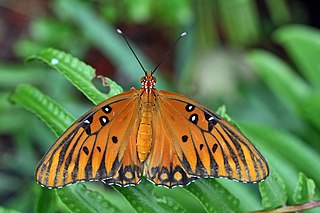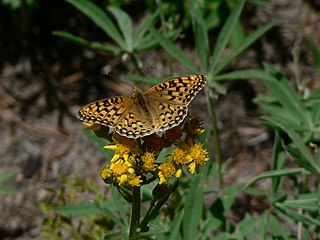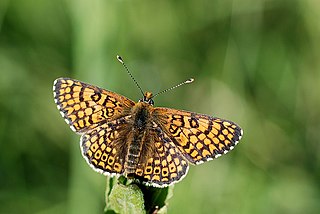
The Gulf fritillary or passion butterfly is a bright orange butterfly in the subfamily Heliconiinae of the family Nymphalidae. That subfamily was formerly set apart as a separate family, the Heliconiidae. The Heliconiinae are "longwing butterflies", which have long, narrow wings compared to other butterflies.

Polygonia c-album, the comma, is a food generalist (polyphagous) butterfly species belonging to the family Nymphalidae. The angular notches on the edges of the forewings are characteristic of the genus Polygonia, which is why species in the genus are commonly referred to as anglewing butterflies. Comma butterflies can be identified by their prominent orange and dark brown/black dorsal wings.

Speyeria zerene, the zerene fritillary, is a butterfly found in the western portions of the United States and Canada. The species was first described by William John Swainson in 1827.

Boloria selene, known in Europe as the small pearl-bordered fritillary and in North America as the silver-bordered fritillary, is a species of butterfly of the family Nymphalidae. It is found across Europe, Asia and North America, and feeds exclusively on violets in its larval stages. This species prefers wet grassland habitats, where its larval food source, violets, are found. It overwinters in its larval stage, and eggs hatch in the late summer to early autumn. Members of this species are prey for multiple types of birds and other insects.

Fabriciana adippe, the high brown fritillary, is a large and brightly colored butterfly of the family Nymphalidae, native to Europe and across the Palearctic to Japan. It is known for being Great Britain's most threatened butterfly and is listed as a vulnerable species under the Wildlife and Countryside Act 1981. Like other fritillaries it is dependent on warm climates with violet rich flora.

The dark green fritillary is a species of butterfly in the family Nymphalidae. The insect has a wide range in the Palearctic realm - Europe, Morocco, Iran, Siberia, Central Asia, China, Korea, and Japan.

The marsh fritillary is a butterfly of the family Nymphalidae. Commonly distributed in the Palearctic region, the marsh fritillary's common name derives from one of its several habitats, marshland. The prolonged larval stage lasts for approximately seven to eight months and includes a period of hibernation over the winter. The larvae are dependent on the host food plant Succisa pratensis not only for feeding but also for hibernation, because silken webs are formed on the host plant as the gregarious larvae enter hibernation. Females lay eggs in batches on the host plant and are, like other batch-layers, selective about the location of oviposition because offspring survivorship levels for batch-layers are more tied to location selection than they are for single-egg layers.

The Glanville fritillary is a butterfly of the family Nymphalidae. It is named for the naturalist who discovered it and the checkerboard pattern on its wings. These butterflies live in almost all of Europe, especially Finland, and in parts of northwest Africa. They are absent from the far north of Europe and parts of the Iberian Peninsula. To the east they are found across the Palearctic.

The Uncompahgre fritillarybutterfly is a species of butterfly in the Order Lepidoptera: Family Nymphalidae that is endemic to Colorado, USA.

The scarce fritillary is a species of butterfly in the family Nymphalidae. It is found in Austria, Bulgaria, Czech Republic, Finland, France, Germany, Greece, Hungary, Kazakhstan, Lithuania, Luxembourg, Poland, Romania, Russia, Serbia and Montenegro, and Sweden.

The callippe silverspot butterfly is a federal endangered species in the brush-footed butterfly family Nymphalidae. This is a subspecies. It is a member of the Heliconiinae, the subfamily known as longwings. The adult has a wingspan of just over two inches. The wings are eyecatching with a brown, tan, and black scalloped pattern on their surfaces and orange-brown with characteristic silver spots on the undersides. The wings and abdomen are hairy. The larvae are spiny, dark-colored caterpillars.

Myrtle's silverspot is a medium-sized butterfly in the brush foot family (Nymphalidae), an endangered subspecies of the zerene fritillary. It is endemic to California, where it is known from only about four locations just north of the San Francisco Bay Area, including two at Point Reyes National Seashore. Its wingspan is approximately 2.2 inches (56 mm). The upper surfaces of the wings are golden brown with numerous black spots and lines. The undersides are brown, orange and tan with black lines and silver and black spots. Larvae are dark colored with many sharp branching spines on their backs. Myrtle's silverspot is larger and paler than the closely related Behrens' silverspot, which is now limited to the vicinity of Point Arena in Mendocino County.

The regal fritillary is a striking nymphalid butterfly found among some of the remaining tallgrass and mixed-grass prairies in the east-central United States. This prairie-specialist butterfly has a characteristic deep orange color and unmistakable dark hindwings with two bands of spots. On the female, both bands of spots are white. However, on the male, the outer band of spots is orange in color. Females also tend to be slightly larger than males. The ventral surface of the hindwings is olive brown to black in color with bold silvery white spots. The wingspan of S. idalia usually measures 68–105 millimetres (2.7–4.1 in). Flight is in the summertime from approximately June to September and adults tend to be swift in flight, coasting close to the ground. It is listed as a species of special concern and believed extirpated in the US state of Connecticut.

The Aphrodite fritillary is a fritillary butterfly, from North America.

Speyeria atlantis, the Atlantis fritillary, is a butterfly of the family Nymphalidae of North America. It is from the Avalon Peninsula of Newfoundland and Labrador to northern British Columbia, across the northern United States south as far as Colorado and West Virginia. It resides as far north as James Bay. The species is listed as endangered in Connecticut.

Speyeria callippe, the callippe fritillary, is a North American species of butterflies in the brush-footed family Nymphalidae.

Speyeria mormonia, commonly known as the Mormon fritillary, is a North American butterfly belonging to the family Nymphalidae. It is highly diverse, having differentiated into several subspecies which occupy a wide geographic range. S. mormonia exhibits extreme protandry, which is the emergence of male adults before female adults. This has several consequences on male and female behavior. Habitat specificity is still being investigated, as there are few known environmental predictors, and S. mormonia appears to be associated with a wide range of habitats. This species is not under threat, and conservation efforts are generally not necessary.

Speyeria adiaste, the unsilvered fritillary or adiaste fritillary, is a species of butterfly of the family Nymphalidae. It is found in California north to San Mateo County and east to north Los Angeles County and Kern County.

Speyeria egleis, commonly known as the Great Basin fritillary or egleis fritillary, is a butterfly of the family Nymphalidae. It is found in North America, where it has been recorded from North Dakota southwest through Oregon to California and south to Colorado. The habitat consists of mountain meadows, forest openings and exposed rocky ridges.
Speyeria carolae, or Carole's fritillary, is a butterfly in the family Nymphalidae. It was described by Cyril Franklin dos Passos and Lionel Paul Grey in 1942 and is found in North America, where it has only been recorded from the Charleston Mountains of Clark County, Nevada. The habitat consists of mountain slopes, foothills and forest openings.




















